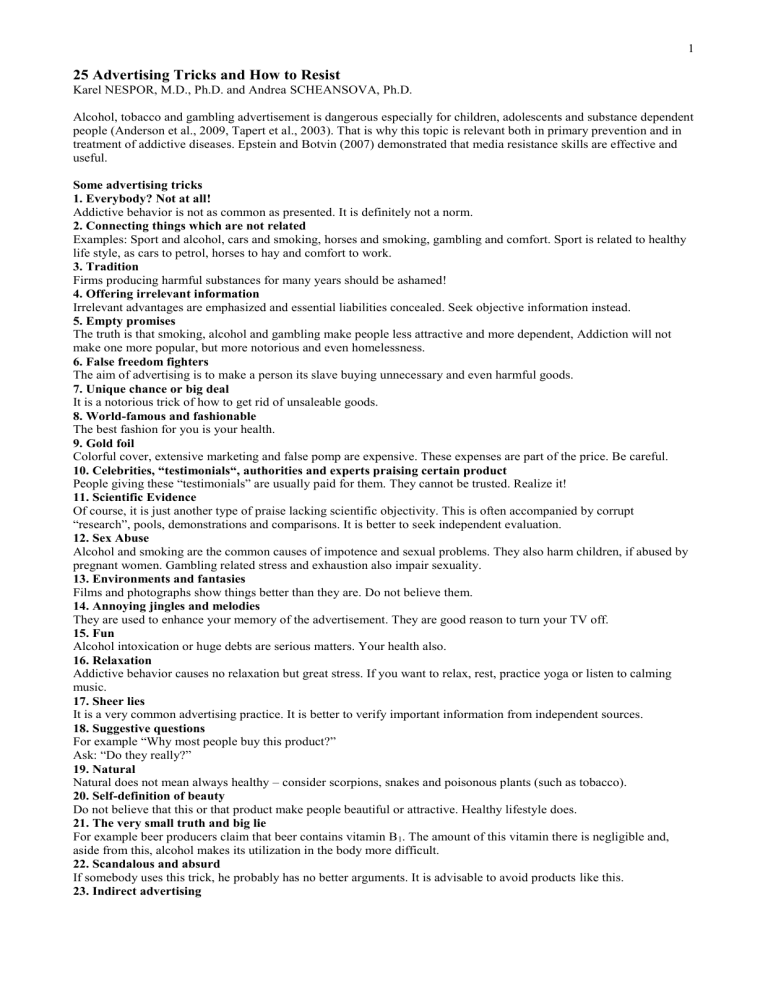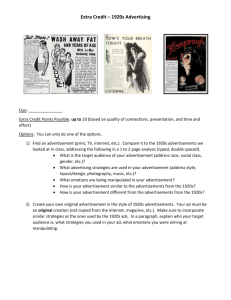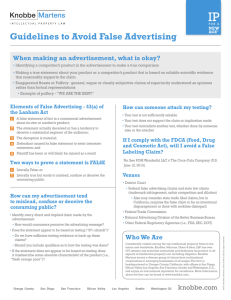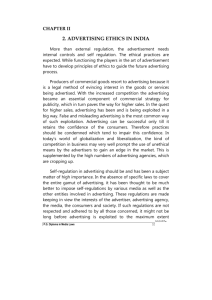25 Advertising Tricks and How to Resist

1
25 Advertising Tricks and How to Resist
Karel NESPOR, M.D., Ph.D. and Andrea SCHEANSOVA, Ph.D.
Alcohol, tobacco and gambling advertisement is dangerous especially for children, adolescents and substance dependent people (Anderson et al., 2009, Tapert et al., 2003). That is why this topic is relevant both in primary prevention and in treatment of addictive diseases. Epstein and Botvin (2007) demonstrated that media resistance skills are effective and useful.
Some advertising tricks
1. Everybody? Not at all!
Addictive behavior is not as common as presented. It is definitely not a norm.
2. Connecting things which are not related
Examples: Sport and alcohol, cars and smoking, horses and smoking, gambling and comfort. Sport is related to healthy life style, as cars to petrol, horses to hay and comfort to work.
3. Tradition
Firms producing harmful substances for many years should be ashamed!
4. Offering irrelevant information
Irrelevant advantages are emphasized and essential liabilities concealed. Seek objective information instead.
5. Empty promises
The truth is that smoking, alcohol and gambling make people less attractive and more dependent, Addiction will not make one more popular, but more notorious and even homelessness.
6. False freedom fighters
The aim of advertising is to make a person its slave buying unnecessary and even harmful goods.
7. Unique chance or big deal
It is a notorious trick of how to get rid of unsaleable goods.
8. World-famous and fashionable
The best fashion for you is your health.
9. Gold foil
Colorful cover, extensive marketing and false pomp are expensive. These expenses are part of the price. Be careful.
10. Celebrities, “testimonials“, authorities and experts praising certain product
People giving these “testimonials” are usually paid for them. They cannot be trusted. Realize it!
11. Scientific Evidence
Of course, it is just another type of praise lacking scientific objectivity. This is often accompanied by corrupt
“research”, pools, demonstrations and comparisons. It is better to seek independent evaluation.
12. Sex Abuse
Alcohol and smoking are the common causes of impotence and sexual problems. They also harm children, if abused by pregnant women. Gambling related stress and exhaustion also impair sexuality.
13. Environments and fantasies
Films and photographs show things better than they are. Do not believe them.
14. Annoying jingles and melodies
They are used to enhance your memory of the advertisement. They are good reason to turn your TV off.
15. Fun
Alcohol intoxication or huge debts are serious matters. Your health also.
16. Relaxation
Addictive behavior causes no relaxation but great stress. If you want to relax, rest, practice yoga or listen to calming music.
17. Sheer lies
It is a very common advertising practice. It is better to verify important information from independent sources.
18. Suggestive questions
For example “Why most people buy this product?”
Ask: “Do they really?”
19. Natural
Natural does not mean always healthy – consider scorpions, snakes and poisonous plants (such as tobacco).
20. Self-definition of beauty
Do not believe that this or that product make people beautiful or attractive. Healthy lifestyle does.
21. The very small truth and big lie
For example beer producers claim that beer contains vitamin B
1
. The amount of this vitamin there is negligible and, aside from this, alcohol makes its utilization in the body more difficult.
22. Scandalous and absurd
If somebody uses this trick, he probably has no better arguments. It is advisable to avoid products like this.
23. Indirect advertising
Somebody pays huge money for advertising and the publisher writes something very nice about the product. This celebration is not, of course, marked as advertisement. The forms of indirect advertisement (intentional or unintentional) are also smoking, gambling or drinking people on TV.
24. Subliminal advertising
Information is perceived but not realized and critically examined. For example the driver does not read the billboards but information from them enters his brain and influences his behavior. TV or radio from another room work similarly.
Avoid subliminal advertising of harmful products!
25. Advertising often attacks emotions. Use sober reason to resist it!
Some possibilities of how to train resistance
• Analyzing different types of media (TV, Internet, journals, etc.), their strengths and weaknesses and the types of advertisement which they use.
• Analyzing concrete advertisements according to target group (age or social group, men or women, etc.).
•
Analyzing the content of concrete advertisements and their deceptive and manipulative techniques.
• Distinguishing between the welfare of people and self-interest of marketing companies.
• Creating anti-advertisements. A well known example is a dead camel with the information that smoking is harmful for camels.
• Creating advertisements for healthy lifestyles.
A teacher or a therapist may ask questions such as:
• Is it in your interest?
• Is it correct or deceptive?
• What does the advertiser gain from it?
• What do they promise and what is the reality?
• What are the hidden and false messages of these advertisements?
• How to protect oneself against the negative influence of advertisement?
It is possible to use special forms containing e.g. following items (partially according Botvin, 2000).
Analyzing advertisements
Advertised product or service:
Its brief description:
Target group:
Tricks used:
Risks for the receiver (loss of money and time, health risks, disappointment, etc.):
Advantages if avoiding or refusing this advertisement:
Conclusion
Advertising of harmful products is dangerous especially for children, adolescents and people with addictive diseases.
We review some advertising techniques and mention ways of how to increase resistance against the advertisement of addictive products.
Advertisements often attack the self-confidence of their receivers and offer false ways of how to increase selfconfidence which they lowered. Advertisement of harmful products often works with emotions and the resistance training usually strengthens rational and critical thinking.
References
Anderson P, de Bruijn A, Angus K, Gordon R, Hastings G. Impact of Alcohol Advertising and Media Exposure on
Adolescent Alcohol Use: A Systematic Review of Longitudinal Studies. Alcohol Alcohol. 2009 [Epub ahead of print]. http://alcalc.oxfordjournals.org/cgi/content/full/agn115v1, accessed 2.2.2009
Brand DA, Saisana M, Rynn LA, Pennoni F, Lowenfels AB. Comparative analysis of alcohol control policies in 30 countries. PLoS Med. 2007;4(4):e151.
Epstein JA, Botvin GJ. Media resistance skills and drug skill refusal techniques: What is their relationship with alcohol use among inner-city adolescents? Addict Behav. 2008;33(4):528-37
Tapert SF, Cheung EH, Brown GG, Frank LR, Paulus MP, Schweinsburg AD, Meloy MJ, Brown SA. Neural response to alcohol stimuli in adolescents with alcohol use disorder. Arch Gen Psychiatry. 2003;60(7):727-35.
2








